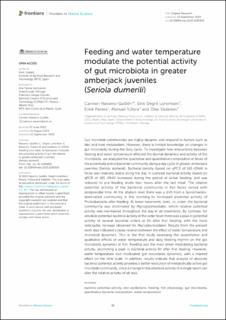| dc.contributor.author | Navarro-Guillén, Carmen | |
| dc.contributor.author | Degré Lorentsen, Eirik | |
| dc.contributor.author | Perera, Erick | |
| dc.contributor.author | Yúfera, Manuel | |
| dc.contributor.author | Vadstein, Olav | |
| dc.date.accessioned | 2024-02-29T09:04:13Z | |
| dc.date.available | 2024-02-29T09:04:13Z | |
| dc.date.created | 2023-09-13T14:57:03Z | |
| dc.date.issued | 2023 | |
| dc.identifier.citation | Frontiers in Marine Science. 2023, 10 . | en_US |
| dc.identifier.issn | 2296-7745 | |
| dc.identifier.uri | https://hdl.handle.net/11250/3120411 | |
| dc.description.abstract | Gut microbial communities are highly dynamic and respond to factors such as diet and host metabolism. However, there is limited knowledge on changes in gut microbiota during the daily cycle. To investigate how interactions between feeding and water temperature affected the diurnal dynamics and activity of the microbiota, we analyzed the qualitative and quantitative composition in feces of the potentially active bacterial community along a day cycle in greater amberjack juveniles (Seriola dumerili). Bacterial density (based on qPCR of 16S rDNA) in feces was relatively stable along the day. In contrast bacterial activity (based on qPCR of 16S rRNA) increased during the period of active feeding, and was reduced to pre-feeding levels four hours after the last meal. The relative potential activity of the bacterial community in fish feces varied with postprandial time. At the phylum level there was a shift from a Spirochaetes-dominated community in the morning to increased potential activity of Proteobacteria after feeding. At lower taxonomic level, i.e. order, the bacterial community was dominated by Mycoplasmoidales, which relative potential activity was maintained throughout the day in all treatments. By contrast, for absolute potential bacterial activity at the order level there was a peak in potential activity of several bacterial orders at 6h after first feeding, with the most noticeable increase observed for Mycoplasmoidales. Results from the present work also indicated a close relation between the effect of water temperature and microbial dynamics. This is the first study assessing the quantitative and qualitative effects of water temperature and daily feeding rhythm on the gut microbiota dynamics in fish. Feeding was the main driver modulating bacterial activity, promoting a peak in bacterial activity 6h after first feeding. However, water temperature also modulated gut microbiota dynamics, with a marked effect on the time scale. In addition, results indicate that analysis of absolute bacterial potential activity provides a better resolution of metabolically active gut microbial community, since a change in the absolute activity of a single taxon can alter the relative activity of all taxa. | en_US |
| dc.language.iso | eng | en_US |
| dc.publisher | Frontiers | en_US |
| dc.rights | Navngivelse 4.0 Internasjonal | * |
| dc.rights.uri | http://creativecommons.org/licenses/by/4.0/deed.no | * |
| dc.title | Feeding and water temperature modulate the potential activity of gut microbiota in greater amberjack juveniles (Seriola dumerili) | en_US |
| dc.title.alternative | Feeding and water temperature modulate the potential activity of gut microbiota in greater amberjack juveniles (Seriola dumerili) | en_US |
| dc.type | Peer reviewed | en_US |
| dc.type | Journal article | en_US |
| dc.description.version | publishedVersion | en_US |
| dc.subject.nsi | VDP::Generell mikrobiologi: 472 | en_US |
| dc.subject.nsi | VDP::General microbiology: 472 | en_US |
| dc.subject.nsi | VDP::Generell mikrobiologi: 472 | en_US |
| dc.subject.nsi | VDP::General microbiology: 472 | en_US |
| dc.subject.nsi | VDP::Generell mikrobiologi: 472 | en_US |
| dc.subject.nsi | VDP::General microbiology: 472 | en_US |
| dc.source.pagenumber | 15 | en_US |
| dc.source.volume | 10 | en_US |
| dc.source.journal | Frontiers in Marine Science | en_US |
| dc.identifier.doi | 10.3389/fmars.2023.1236305 | |
| dc.identifier.cristin | 2174793 | |
| dc.relation.project | Norges forskningsråd: 338107 | en_US |
| cristin.ispublished | true | |
| cristin.fulltext | original | |
| cristin.qualitycode | 1 | |

